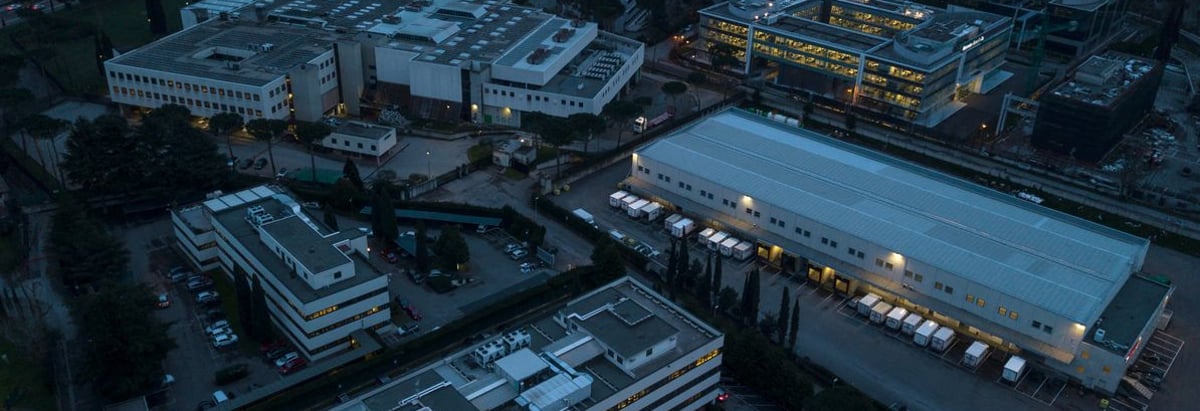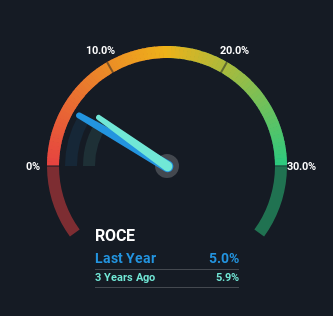
What trends should we look for it we want to identify stocks that can multiply in value over the long term? Ideally, a business will show two trends; firstly a growing return on capital employed (ROCE) and secondly, an increasing amount of capital employed. Put simply, these types of businesses are compounding machines, meaning they are continually reinvesting their earnings at ever-higher rates of return. In light of that, when we looked at CITIC (HKG:267) and its ROCE trend, we weren't exactly thrilled.
Return On Capital Employed (ROCE): What Is It?
Just to clarify if you're unsure, ROCE is a metric for evaluating how much pre-tax income (in percentage terms) a company earns on the capital invested in its business. Analysts use this formula to calculate it for CITIC:
Return on Capital Employed = Earnings Before Interest and Tax (EBIT) ÷ (Total Assets - Current Liabilities)
0.05 = CN¥305b ÷ (CN¥11t - CN¥5.3t) (Based on the trailing twelve months to June 2024).
Thus, CITIC has an ROCE of 5.0%. In absolute terms, that's a low return, but it's much better than the Industrials industry average of 3.6%.
Check out our latest analysis for CITIC

Above you can see how the current ROCE for CITIC compares to its prior returns on capital, but there's only so much you can tell from the past. If you're interested, you can view the analysts predictions in our free analyst report for CITIC .
What Can We Tell From CITIC's ROCE Trend?
In terms of CITIC's historical ROCE trend, it doesn't exactly demand attention. The company has employed 69% more capital in the last five years, and the returns on that capital have remained stable at 5.0%. Given the company has increased the amount of capital employed, it appears the investments that have been made simply don't provide a high return on capital.
On a side note, CITIC's current liabilities are still rather high at 47% of total assets. This effectively means that suppliers (or short-term creditors) are funding a large portion of the business, so just be aware that this can introduce some elements of risk. While it's not necessarily a bad thing, it can be beneficial if this ratio is lower.
In Conclusion...
In conclusion, CITIC has been investing more capital into the business, but returns on that capital haven't increased. Since the stock has gained an impressive 44% over the last five years, investors must think there's better things to come. Ultimately, if the underlying trends persist, we wouldn't hold our breath on it being a multi-bagger going forward.
If you want to know some of the risks facing CITIC we've found 2 warning signs (1 can't be ignored!) that you should be aware of before investing here.
While CITIC isn't earning the highest return, check out this free list of companies that are earning high returns on equity with solid balance sheets.
New: AI Stock Screener & Alerts
Our new AI Stock Screener scans the market every day to uncover opportunities.
• Dividend Powerhouses (3%+ Yield)
• Undervalued Small Caps with Insider Buying
• High growth Tech and AI Companies
Or build your own from over 50 metrics.
Have feedback on this article? Concerned about the content? Get in touch with us directly. Alternatively, email editorial-team (at) simplywallst.com.
This article by Simply Wall St is general in nature. We provide commentary based on historical data and analyst forecasts only using an unbiased methodology and our articles are not intended to be financial advice. It does not constitute a recommendation to buy or sell any stock, and does not take account of your objectives, or your financial situation. We aim to bring you long-term focused analysis driven by fundamental data. Note that our analysis may not factor in the latest price-sensitive company announcements or qualitative material. Simply Wall St has no position in any stocks mentioned.
About SEHK:267
CITIC
Operates in financial services, advanced intelligent manufacturing, advanced materials, consumption, urbanization, resources and energy, and engineering contracting businesses worldwide.
Undervalued second-rate dividend payer.
Similar Companies
Market Insights
Community Narratives




